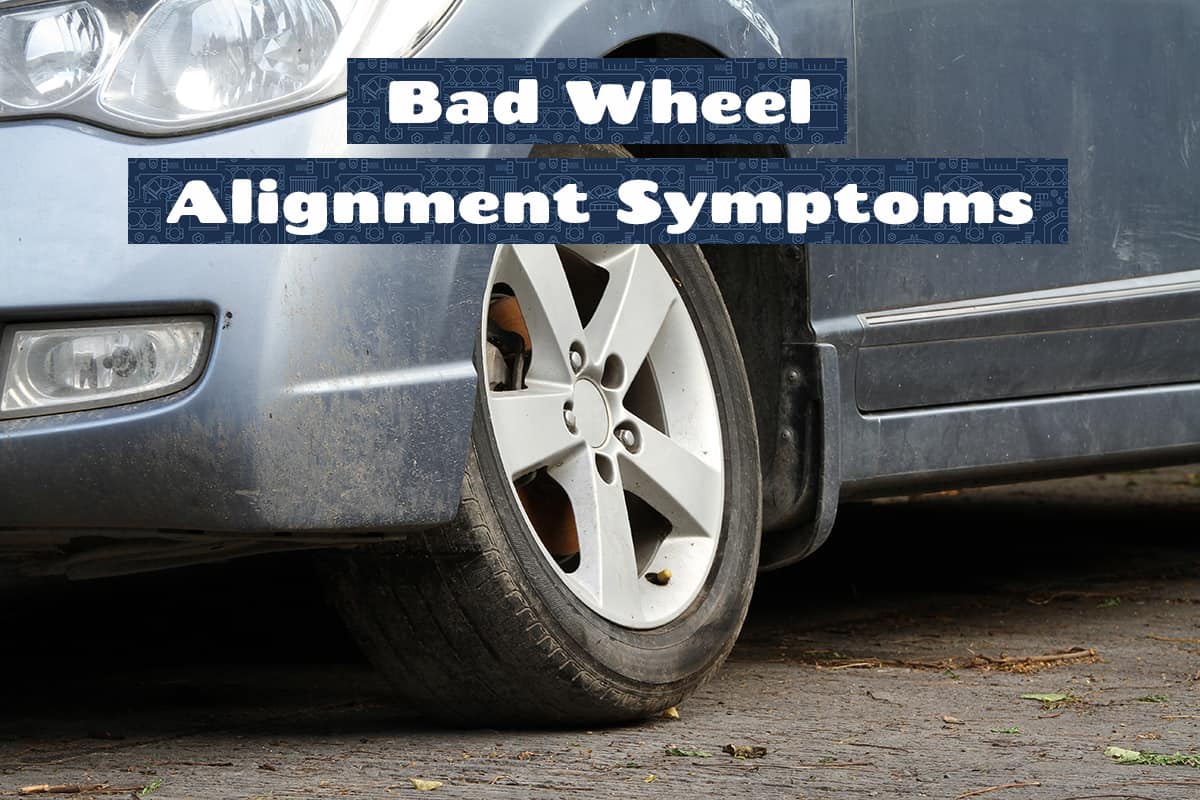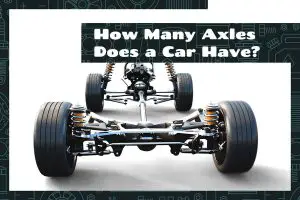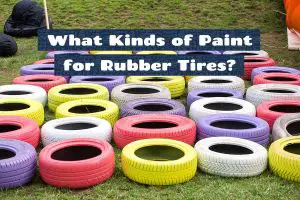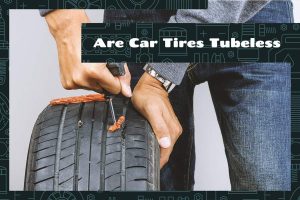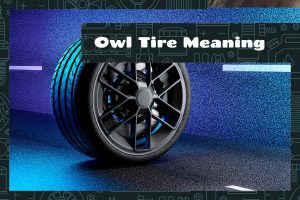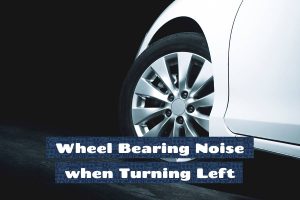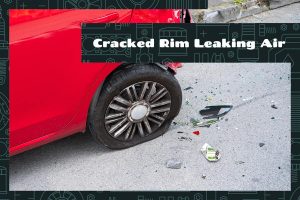Proper wheel alignment plays a role in safety and comfort. It’s the calibration of a car’s wheels to ensure they’re perfectly parallel to each other and perpendicular to the road. A misalignment, even if slight, can affect driving experience and pocketbook.
The most common symptoms associated with bad wheel alignment are as follows:
- Vehicle pulling to one side
- Uneven tire wear patterns
- Steering wheel vibrations
- Crooked or off-center steering wheel
- Decreased fuel efficiency
- Squealing tires
Below, we’ll take a closer look at these symptoms of bad wheel alignment, as well as provide step-by-step solutions for resolving this major problem.
What Is Wheel Alignment?
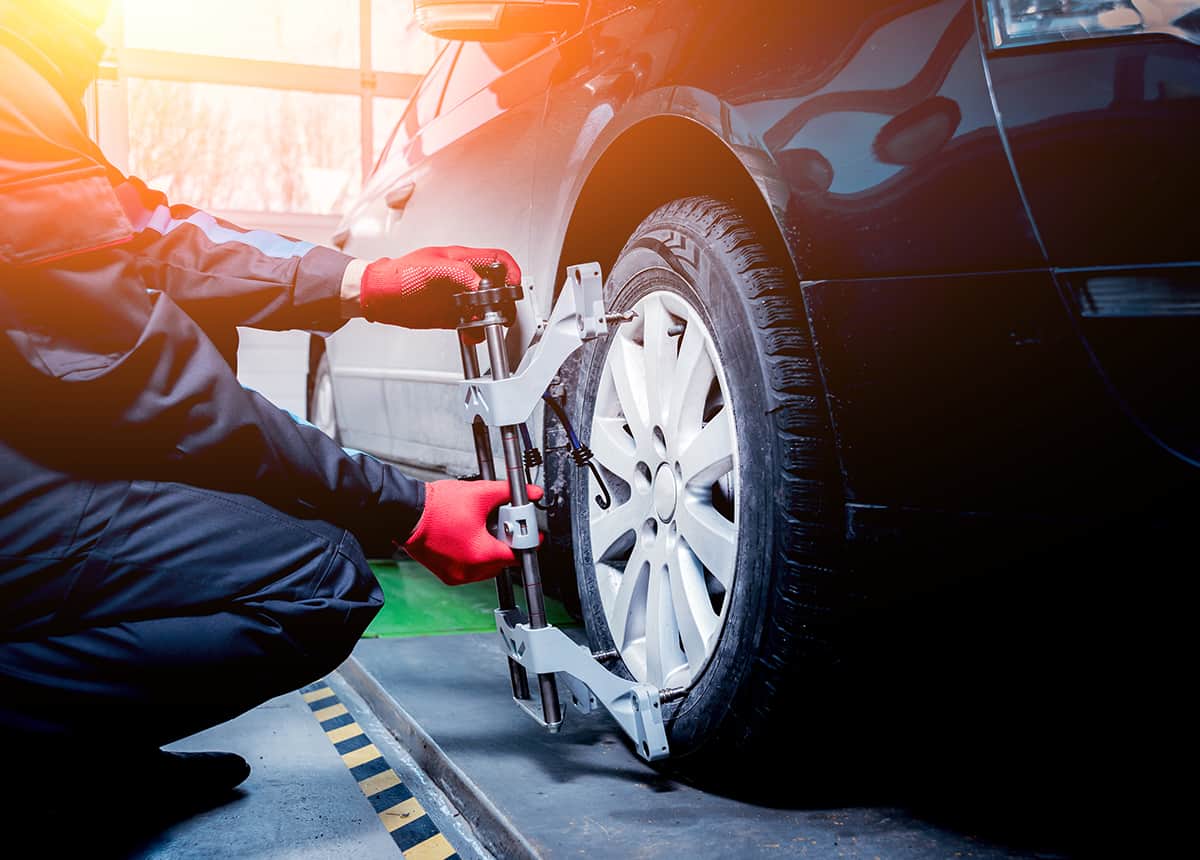
Wheel alignment, often simply referred to as “alignment,” is a standard automotive procedure that ensures a vehicle’s wheels are set to the car manufacturer’s specifications. It guarantees that the wheels are not only parallel to each other but are also perpendicular to the ground. Keeping your vehicle’s wheel aligned properly optimizes vehicle performance, longevity, and safety.
At the foundation of wheel alignment are three primary angles—camber, caster, and toe. These angles determine how each wheel interacts with the road surface and dictate the car’s handling, stability, and how quickly the tires might wear out.
Camber
This angle is observed when you look at the wheels from the front of your car. If the top of the wheel leans outward away from the car, it’s referred to as positive camber. If it leans in towards the car, it’s negative camber. Incorrect camber can cause the tire to wear out excessively on one side.
Caster
To understand caster, think of the front wheels on a shopping cart. The pivot at which the wheels turn is set in such a way that the wheels align perfectly under the handle. In cars, the caster angle assists in the steering’s self-centering action. A positive caster means the steering axis tilts towards the driver, while a negative caster means it tilts towards the front of the vehicle. This angle is related to balance and stability, especially at high speeds.
Toe
This refers to whether the front of the tires are closer (toe-in) or further apart (toe-out) than the rear of the tires when viewed from above. Imagine looking down at your own feet: pointing them inwards is like toe-in, and pointing them outwards is toe-out. Correct toe alignment ensures that the tires roll parallel and reduces the chances of premature tire wear.
Primary Symptoms of Bad Wheel Alignment
Visually inspecting your car’s tires for alignment issues requires a keen eye—something we might not possess as laymen with minimal car knowledge. However, the following symptoms are a lot more noticeable and may indicate bad wheel alignment.
1. Vehicle Pulling to One Side
This pulling sensation means that while you’re trying to drive straight, the car has a noticeable tendency to drift, requiring constant steering correction. This symptom not only makes driving tedious but can also be a safety concern, especially at higher speeds or in wet conditions.
2. Uneven or Rapid Tire Wear
Tire wear is a natural consequence of driving, but when tires wear unevenly or faster than usual, it can indicate alignment issues. Specific patterns of wear can offer clues:
- Edge Wear: Accelerated wear on the inner and/or outer edges of your tires.
- Feathering or Scalloping: This is when one edge of the tire, either the inner or outer edge, wears down faster than the opposite edge.
3. Vibrating Steering Wheel
This vibration is caused by the tires pulling in opposite directions, leading to an uncomfortable shuddering sensation in the steering wheel. It’s not just an inconvenience; prolonged driving with this symptom can wear out other vehicle components faster.
4. Steering Wheel Not Centered
When driving straight, the emblem on the steering wheel should be level. If it’s noticeably off-center either to the left or right, it’s a sign that the wheels might not be correctly aligned. While this might seem like a minor issue, an off-center steering wheel can indicate more significant underlying alignment problems.
5. Decreased Fuel Efficiency
While not as immediate as the other symptoms, poor wheel alignment can lead to reduced fuel efficiency. Misaligned wheels can increase rolling resistance, meaning the engine has to work harder to move the vehicle, consuming more fuel in the process. Over time, this decreased efficiency can add up.
6. Squealing Tires
A less common but evident symptom is the squealing of tires, especially when turning. This noise is due to the additional stress and friction on the tire from not being correctly aligned to the road’s surface. The squealing might be intermittent at first but can become more consistent as the misalignment worsens.
Causes of Bad Wheel Alignment
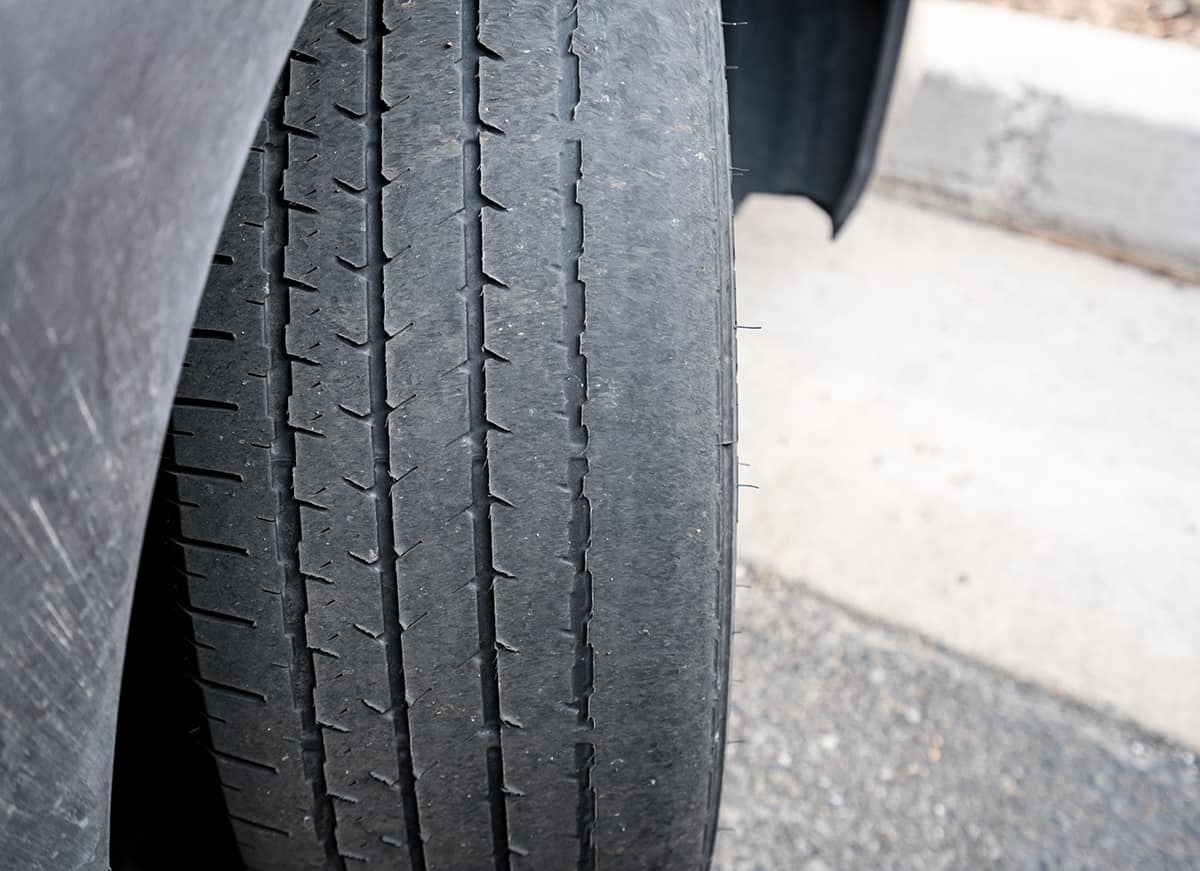
For any vehicle owner, maintaining proper wheel alignment ensures the best performance, safety, and longevity of tires. However, a variety of factors can lead to poor alignment.
1. Normal Wear and Tear
As vehicles age, components of the suspension system naturally degrade. Springs can become less resilient, and bushings might wear out. This wear and tear can gradually alter the wheel alignment. Even under normal driving conditions, a car’s alignment can change over time. The change can be subtle, but over extended periods, it can lead to noticeable misalignment.
2. Impact from Potholes or Curbs
Driving on poorly maintained roads can be a primary culprit for bad wheel alignment. Potholes, in particular, can be especially damaging. When a wheel hits a pothole at speed, the abrupt and forceful impact can jolt the wheel out of its proper alignment. Similarly, hitting curbs, whether it’s from parking too hastily or misjudging a turn, may lead to identical effects.
3. Accidents
Even minor accidents can lead to alignment issues. A fender bender or a more substantial collision can force the wheels out of alignment. In some instances, other components of the vehicle might also get damaged, leading to more pronounced alignment problems.
Other Factors Leading to Misalignment
Apart from the common causes mentioned above, several other factors can lead to wheel misalignment:
- Manufacturing Defects: Though rare, manufacturing errors can result in misaligned wheels right off the assembly line. It’s always a good practice for new car owners to pay attention to any alignment symptoms early on.
- Suspension Modifications: Altering the suspension system, whether it’s for enhanced performance, aesthetics, or off-road capabilities, can change the alignment.
How to Realign Tires
As serious as misaligned tires can be, the solution is quite simple—just realign your car’s tires. You can try doing this on your own (DIY method) or have a professional mechanic do the deed for you (we recommend doing the latter).
DIY Wheel Alignment Steps
This is a simplified guide based on 1A Auto’s video tutorial:
- Gathering Necessary Tools: You’ll need a wheel alignment kit, which can be purchased online or at auto parts stores. Other essential tools include a jack, jack stands, a wrench set, and tape measure.
- Preparation: Begin by parking on a level surface. Ensure the steering wheel is centered and that the vehicle is in neutral. Use the jack to lift the car and then set it on jack stands.
- Measuring Toe: Attach string or a laser line to the front and rear outer edges of the tires. Measure the distance between the string or laser line at the front and rear of the tire. Adjust the tie rods to achieve the desired toe setting.
- Adjusting Camber: Using your alignment kit, measure the camber. If adjustments are needed, this often requires loosening the bolts on the strut and realigning the wheel. Once achieved, tighten the bolts.
- Checking Caster: Caster adjustments are more complex and may require specialized tools or kits. If your vehicle’s caster needs adjustment, consider seeking professional assistance.
- Test Drive and Recheck: After making adjustments, carefully lower the car from the jack stands. Take a short test drive, then recheck the alignment. Fine-tune as necessary.
